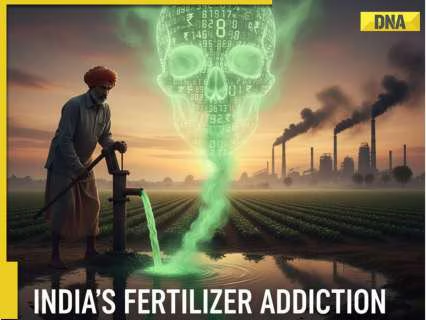
The chemical that once fed a hungry nation is now poisoning its groundwater, fueling disease, and deepening the climate crisis, all paid for by public money.
India has long celebrated the Green Revolution a miracle that helped feed over a billion people and turned the country into an agricultural powerhouse. But behind this story of self-reliance lies a far more toxic truth. We are now caught in a dangerous paradox: the same chemical-synthetic nitrogen, that once saved us from starvation is now slowly poisoning our water, polluting our air, and draining our national finances.
The numbers are alarming. India spent Rs 1.91 lakh crore in 2024–25 just on subsidizing urea, one of the most commonly used nitrogen fertilizers. That’s more than the combined budgets of education, health, and environment ministries. And what do we get in return? Only 20–30% of this nitrogen is actually absorbed by crops. The rest, nearly 80% leaks into our environment, contaminating water, damaging soil, and releasing dangerous gases into our atmosphere.
This is not just waste. It’s a silent tsunami that affects every Indian family from the food we eat, to the water we drink, to the air we breathe.
A Miracle Turned Menace: The Story of Nitrogen
The invention of synthetic nitrogen, through the Haber-Bosch process, is one of the greatest scientific breakthroughs of the 20th century. It enabled humanity to grow enough food for a rapidly increasing population hence the phrase “bread from air.”
In India, synthetic nitrogen became the backbone of agriculture, especially after the Green Revolution. But over time, it turned into a monopoly input. Today, over 70% of the nitrogen used in Indian cereal farming comes from chemical fertilizers like urea. And because this urea is heavily subsidized, farmers have every incentive to use more than needed, even when the land doesn’t require it.
This “more-is-better” approach has created a vicious cycle of declining soil health, rising input dependency, and ever-growing subsidies.
The 80% Waste Problem: Where Does All That Nitrogen Go?
Here’s the hard truth: 80% of the nitrogen applied on Indian fields doesn’t help the crop at all. It gets lost through:
•Volatilization (released into the air as ammonia or nitrous oxide)
Surface runoff (washed into rivers and lakes)
Leaching (seeping into groundwater)
And that’s not just bad science. It’s economic suicide. We’re literally pouring taxpayer money into the soil, only to see it poison the environment.
Global studies estimate that nitrogen waste costs the world $200 billion every year. In India, this cost is borne directly by the government and indirectly by citizens who face the consequences – contaminated water, poor crop quality, and rising healthcare
expenses.
The Poison in Your Water: India’s Groundwater Emergency
This is where the crisis becomes personal.
As per the Central Groundwater Board (CGWB) report 2023, official data shows that 440 districts in India have groundwater contaminated with nitrate levels above the safe limit of 45 mg/litre. This number has risen significantly in recent years.
High nitrate levels in drinking water are known to cause:
Blue Baby Syndrome in infants
Thyroid and hormonal imbalances
Stomach cancers and other chronic illnesses
Imagine this: You might be drinking government-subsidized poison every day, without even knowing it. And while richer households can afford RO purifiers or bottled water, millions in rural India cannot.
The Rs 1.91 lakh crore urea subsidy is therefore not just a farming input; it’s a direct driver of a nationwide health crisis.
A Climate Time-Bomb: Fertilizer and Global Warming
The environmental cost doesn’t stop at water.
The process of making and using urea contributes to 4.3% of India’s total greenhouse gas emissions. In agriculture alone, urea is responsible for 22% of sectoral emissions.
Worse still, the nitrogen that leaks from soil becomes Nitrous Oxide (N₂O) a gas 273 times more potent than CO₂ in warming the planet. Since 2020, N₂O has also become the leading cause of stratospheric ozone depletion, surpassing CFCs.
Let that sink in: the chemical we subsidize most heavily is now not only fuelling climate change, but also damaging the ozone layer we fought so hard to protect.
Our Coasts Are Dying Too
Excess nitrogen doesn’t just stay in the soil or air. It travels with rainwater into rivers and eventually reaches the sea. Along India’s vast coastline, this has led to eutrophication an unnatural nutrient surge that causes algae blooms, kills marine life, and creates “dead zones” with no oxygen.
Globally, such dead zones cause massive economic losses to fisheries and coastal communities. In South Asia, they pose a direct threat to millions who depend on the sea for food and livelihood.
Government Efforts: Steps in the Right Direction
To its credit, the Indian government has not turned a blind eye. Since 2015, it has mandated 100% neem-coated urea a low-cost innovation that slows nitrogen releases and reduces losses. This has improved Nitrogen Use Efficiency and helped cut down illegal diversion of urea.
In 2023, the PM-PRANAM scheme was launched, aiming to reduce chemical fertilizer use by rewarding states financially when they save subsidies. Under this model, states receive 50% of the subsidy savings if they reduce fertilizer usage compared to the past three years. The idea: shift from paying for quantity to incentivizing efficiency.
There’s also hope in Nano Urea a smart fertilizer designed for slow, efficient nitrogen delivery. However, field adoption remains low because of higher spraying labour costs, which are discouraging for small farmers.
What Needs to Happen Next: Precision, Policy, and People
India has committed under the Global Biodiversity Framework to cut nitrogen
pollution by 50% by 2030. That’s just 5 years away.
To make this happen, three things are non-negotiable:
Precision Farming: Use of drones, satellite mapping, and soil sensors to apply nitrogen only where needed.
Biological Alternatives: Like bacteria-based sprays that can fix nitrogen naturally these have shown yield gains of up to 500 kg/hectare in trials.
Policy Reform: Fully decouple fertilizer subsidies from consumption volume and shift to performance-based payouts that reward higher efficiency.
Crucially, the government must win farmer trust by showing that less fertilizer doesn’t mean less yield. The Netherlands learned this the hard way, massive farmer protests erupted when livestock and fertilizer cuts were forced top-down. India must walk a path that protects both the farmer’s income and the nation’s environment.
Are We Feeding Ourselves to Death?
At the heart of India’s fertilizer crisis lies a difficult truth: Our food security is being paid for with poisoned groundwater, rising climate debt, and a ballooning subsidy bill.
The Rs 1.91 lakh crore spent on urea each year could fund:
3 AIIMS-like hospitals in every state
National clean water access programs
Major renewable energy infrastructure
Instead, it goes into the soil most of it wasted, only to come back as nitrate in your glass of water or N₂O in your atmosphere.
India now stands at a turning point. The tools to fix this problem exist. What’s needed is political will, farmer-centric solutions, and a national awakening that food security cannot come at the cost of public health and planetary stability.
Because when nitrogen becomes poison, no subsidy can save us





